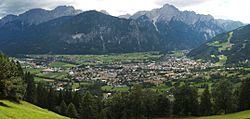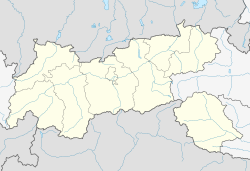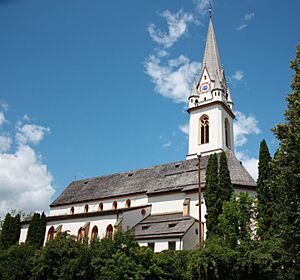Lienz facts for kids
Quick facts for kids
Lienz
Lianz
|
|||
|---|---|---|---|
|
From top down, left to right: Main Square, City Hall (former Schloss Liebburg), Lienz as seen from the North, Burg Bruck, Iselsteg bridge and Iselturm
|
|||
|
|||
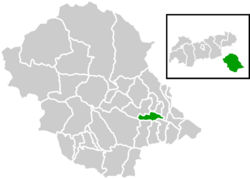
Location within Lienz district
|
|||
| Country | Austria | ||
| State | Tyrol | ||
| District | Lienz | ||
| Area | |||
| • Total | 15.94 km2 (6.15 sq mi) | ||
| Elevation | 673 m (2,208 ft) | ||
| Time zone | UTC+1 (CET) | ||
| • Summer (DST) | UTC+2 (CEST) | ||
| Postal code |
9900
|
||
| Area code | 04852 | ||
| Vehicle registration | LZ | ||
| Website | www.stadt-lienz.at | ||
Lienz is a cool medieval town in Tyrol, a state in Austria. It's the main city of the Lienz area, which covers all of East Tyrol. The town also includes a part called Patriasdorf.
Contents
Where is Lienz? (Geography)
Lienz is located where two rivers, the Isel and the Drava, meet. This area is in the Eastern Alps mountains. To the north, you'll find the Hohe Tauern mountain range, and to the south, the Gailtal Alps.
The town is connected to Winklern in Carinthia by a mountain pass called Iselsberg Pass. The nearby town of Leisach marks the eastern end of the Puster Valley.
As Lienz has grown, some smaller villages nearby are now seen as part of the city, even though they are officially separate towns. These include:
| Thurn, Gaimberg | ||
| Leisach, Oberlienz | 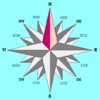 |
Nußdorf-Debant |
| Amlach, Tristach |
Lienz Through Time (History)
People have lived in the Lienz area since the Bronze Age, around 2000 BC. Later, Celtic people arrived around 300 BC. They were mainly miners.
Around 15 BC, the Roman Empire took control. The area became part of a Roman province called Noricum. The Roman Emperor Claudius even built a Roman town, or municipium, called Aguntum near Lienz. This town had an early Christian bishop in the 5th century. However, it slowly fell apart during conflicts with other groups around 600 AD.
Lienz was first mentioned by name as Luenzina around 1030. It was owned by the Patriarchs of Aquileia, who were important leaders. Later, a powerful family called the Meinhardiner bought Lienz and made it their home. They were known as the Counts of Görz.
Lienz was an important stop on a trade route from Venzone to Salzburg. Because of its importance, it was given special city rights on February 25, 1242. In 1278, the Counts finished building Burg Bruck, a castle that was their home until 1500.
When the Counts of Görz family ended in 1500, their lands went to the Habsburg King Maximilian I. Lienz then became part of the County of Tyrol. It went from being a royal residence to a smaller town within the Habsburg monarchy.
During the French Revolutionary Wars, French soldiers took over Lienz twice in 1797. After Austria lost a big battle in 1805, Lienz became part of the Kingdom of Bavaria. Later, it was part of a short-lived French area called the Illyrian Provinces but was taken back by Austrian soldiers in 1813.
After World War I, parts of Tyrol went to Kingdom of Italy. This made the Lienz district of East Tyrol an exclave, meaning it was separated from the rest of North Tyrol by another country.
In 1938, when Nazi Germany took over Austria, the Lienz district became part of a region called Reichsgau Kärnten.
On May 8, 1945, British forces arrived in Lienz. At this time, many soldiers from the former German army, called the Wehrmacht 1st Cossack Division, came to Lienz from Yugoslavia. They surrendered to the British troops. These soldiers were then sent to the Soviet Union.
Weather in Lienz (Climate)
Lienz has summers that are quite warm and humid, and winters that are cold. On average, it gets about 915 millimeters (about 36 inches) of rain each year. Most of the rain falls during the summer months, especially from June to August. January and February are the driest months.
The average temperature in July is about 17.9°C (64.2°F). In January, it's much colder, around -5.2°C (22.6°F). Lienz is also one of the sunniest cities in Austria, getting about 5.4 hours of sunshine per day. This type of climate is called "humid continental."
| Weather chart for Lienz | |||||||||||||||||||||||||||||||||||||||||||||||
|---|---|---|---|---|---|---|---|---|---|---|---|---|---|---|---|---|---|---|---|---|---|---|---|---|---|---|---|---|---|---|---|---|---|---|---|---|---|---|---|---|---|---|---|---|---|---|---|
| J | F | M | A | M | J | J | A | S | O | N | D | ||||||||||||||||||||||||||||||||||||
|
42
0
-9
|
35
5
-6
|
59
10
-2
|
66
14
2
|
85
19
7
|
98
23
10
|
119
25
12
|
100
24
12
|
89
21
8
|
96
14
3
|
77
6
-3
|
50
0
-7
|
||||||||||||||||||||||||||||||||||||
| temperatures in °C precipitation totals in mm source: ZAMG |
|||||||||||||||||||||||||||||||||||||||||||||||
|
Imperial conversion
|
|||||||||||||||||||||||||||||||||||||||||||||||
| Climate data for Lienz (1971–2000) | |||||||||||||
|---|---|---|---|---|---|---|---|---|---|---|---|---|---|
| Month | Jan | Feb | Mar | Apr | May | Jun | Jul | Aug | Sep | Oct | Nov | Dec | Year |
| Record high °C (°F) | 12.9 (55.2) |
21.0 (69.8) |
24.0 (75.2) |
25.9 (78.6) |
30.0 (86.0) |
33.0 (91.4) |
37.7 (99.9) |
33.7 (92.7) |
30.0 (86.0) |
26.0 (78.8) |
17.2 (63.0) |
15.5 (59.9) |
37.7 (99.9) |
| Mean daily maximum °C (°F) | 0.1 (32.2) |
4.7 (40.5) |
10.1 (50.2) |
14.4 (57.9) |
19.3 (66.7) |
22.5 (72.5) |
24.9 (76.8) |
24.4 (75.9) |
20.5 (68.9) |
14.2 (57.6) |
5.7 (42.3) |
0.2 (32.4) |
13.4 (56.1) |
| Daily mean °C (°F) | −5.2 (22.6) |
−1.9 (28.6) |
3.1 (37.6) |
7.6 (45.7) |
12.7 (54.9) |
15.9 (60.6) |
17.9 (64.2) |
17.2 (63.0) |
13.0 (55.4) |
7.3 (45.1) |
0.6 (33.1) |
−4.2 (24.4) |
7.0 (44.6) |
| Mean daily minimum °C (°F) | −9.0 (15.8) |
−6.3 (20.7) |
−1.6 (29.1) |
2.1 (35.8) |
6.7 (44.1) |
9.9 (49.8) |
11.8 (53.2) |
11.5 (52.7) |
7.8 (46.0) |
3.0 (37.4) |
−2.7 (27.1) |
−7.3 (18.9) |
2.2 (36.0) |
| Record low °C (°F) | −24.7 (−12.5) |
−24.5 (−12.1) |
−15.6 (3.9) |
−5.7 (21.7) |
−7.4 (18.7) |
1.3 (34.3) |
3.1 (37.6) |
1.8 (35.2) |
−2.2 (28.0) |
−11.6 (11.1) |
−18.8 (−1.8) |
−21.1 (−6.0) |
−24.7 (−12.5) |
| Average precipitation mm (inches) | 42.4 (1.67) |
35.0 (1.38) |
58.6 (2.31) |
65.6 (2.58) |
85.4 (3.36) |
97.8 (3.85) |
119.0 (4.69) |
99.9 (3.93) |
88.5 (3.48) |
96.3 (3.79) |
76.5 (3.01) |
50.1 (1.97) |
915.1 (36.03) |
| Average snowfall cm (inches) | 31.1 (12.2) |
21.6 (8.5) |
21.7 (8.5) |
5.7 (2.2) |
1.0 (0.4) |
0.0 (0.0) |
0.0 (0.0) |
0.0 (0.0) |
0.0 (0.0) |
1.4 (0.6) |
18.1 (7.1) |
29.1 (11.5) |
129.7 (51.1) |
| Average precipitation days (≥ 1.0 mm) | 5.4 | 4.2 | 5.7 | 7.4 | 10.6 | 11.8 | 11.2 | 11.2 | 7.9 | 7.3 | 6.4 | 5.9 | 95.0 |
| Average relative humidity (%) (at 14:00) | 74.1 | 55.4 | 48.6 | 46.8 | 50.5 | 51.7 | 51.0 | 52.7 | 54.4 | 57.8 | 69.7 | 79.9 | 57.7 |
| Mean monthly sunshine hours | 76.1 | 151.2 | 175.4 | 175.8 | 200.2 | 205.6 | 237.5 | 227.7 | 194.1 | 164.6 | 97.0 | 46.2 | 1,952 |
| Percent possible sunshine | 41.7 | 57.5 | 55.3 | 49.9 | 48.6 | 49.8 | 56.4 | 58.5 | 60.2 | 54.4 | 45.5 | 30.0 | 50.7 |
| Source: Central Institute for Meteorology and Geodynamics | |||||||||||||
How Many People Live in Lienz? (Population)
| Historical population | ||
|---|---|---|
| Year | Pop. | ±% |
| 1869 | 2,484 | — |
| 1880 | 3,142 | +26.5% |
| 1890 | 3,878 | +23.4% |
| 1900 | 4,549 | +17.3% |
| 1910 | 6,532 | +43.6% |
| 1923 | 6,591 | +0.9% |
| 1934 | 6,885 | +4.5% |
| 1939 | 8,458 | +22.8% |
| 1951 | 10,096 | +19.4% |
| 1961 | 11,132 | +10.3% |
| 1971 | 11,741 | +5.5% |
| 1981 | 11,661 | −0.7% |
| 1991 | 11,864 | +1.7% |
| 2001 | 12,079 | +1.8% |
| 2011 | 11,955 | −1.0% |
Getting Around Lienz (Transport)
Lienz is an important place for roads. It's where the Drautalstraße highway (B100) meets the Felbertauernstraße (B108). The Drautalstraße goes from Carinthia to the Puster Valley in Italy. The Felbertauernstraße goes from Lienz to Mittersill in Salzburg.
There's also a railway line called the Drautalbahn that connects Lienz from Villach to Innichen in Italy. A tunnel called the Felbertauerntunnel, which helps connect Mittersill and Lienz, was finished in 1967.
Famous People from Lienz (Notable People)
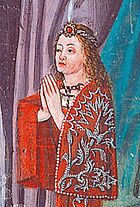
- Leonhard of Gorizia (1440–1500): Born at Burg Bruck castle, he was the last count of Gorizia.
- Albert Anton von Muchar (1786-1849): An Austrian historian who studied the past.
- Beda Weber (1798-1859): An author, a religious scholar, and a member of the Frankfurt Parliament.
- Albin Egger-Lienz (1868-1926): A painter famous for his pictures of country life and historical events.
- Theodor Danegger (1891–1959): A film actor who appeared in over 70 movies.
- Raimund Abraham (1933-2010): An architect who designed buildings.
Sport Stars
- Josef "Pepi" Stiegler (born 1937): Won a gold medal in Alpine skiing at the 1964 Winter Olympics.
- Anton Steiner (born 1958): An Austrian former alpine skier who won a bronze medal at the 1984 Winter Olympics.
- Alexander Lugger (born 1968): An Austrian ski mountaineer and coach for the national team.
- Fritz Strobl (born 1972): A World Cup skier who won a gold medal at the Alpine skiing at the 2002 Winter Olympics.
- Wolfgang Mair (born 1980): An Austrian footballer who played many games.
- Dominic Hassler (born 1981): A former football striker who also played many games.
Lienz Around the World (International Relations)
Lienz has special friendships with other towns around the world. These are called "twin towns" or "sister cities."
Twin towns – Sister cities
Lienz is twinned with:
 Gorizia, Italy, since 2000
Gorizia, Italy, since 2000 Jackson, Wyoming, United States, since 1970
Jackson, Wyoming, United States, since 1970 Selçuk, Turkey, since 1970
Selçuk, Turkey, since 1970
See also
 In Spanish: Lienz para niños
In Spanish: Lienz para niños




